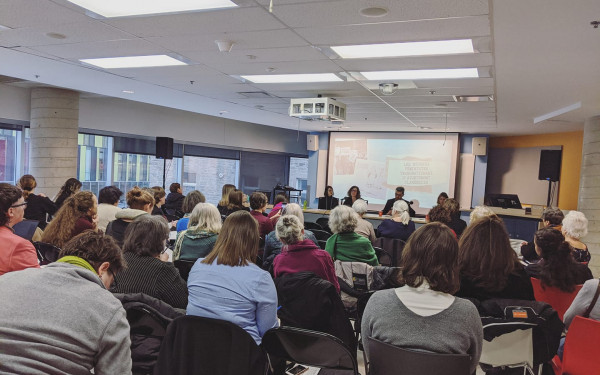Festival Review: Program One of Revolution They Wrote Explores Diverse Intersectionality Through Art
A Peek Into the Fifth Annual Short-Works Feminist Festival
The Revolution They Wrote festival offered viewers and artists an opportunity to stand in solidarity against the oppressive institutions that often bind and maim minority voices.
By bringing the spotlight back onto minority groups, a diverse and inclusive narrative is explored. Fighting for inclusivity by bringing Indigenous, queer, differently-abled and other voices to the spotlight for this revolutionary festival, Revolution They Wrote combines visual and performance art to campaign for a more inclusive now.
Running from March 21 to March 24, audiences had the choice to take on each night for this year’s lineup of Revolution They Wrote plays. While there is an overlapping of themes in each program, the programs differ slightly in set-up and in thematic discourse.
A quick coin toss decided my fate, and Program One it was. The festival’s pamphlet capsulized each program’s themes so audience members could choose which one they feel is best for the night. Program One explored themes of body image, mental illness, transphobia, gender phobia, intergenerational family dynamics, and discussed sex and romance.
As eight o’clock chimes, the audience makes its way from the lobby into one of the two theatres. Luckily both programs take place in the same building, a perfect opportunity to discuss and compare experiences with peers.
The stage is dimly lit, propped for the first act with a chair, a Chinese curtain, and a table with a telephone. “2019 boulevard des limites, [boundaries]” by Christopher Marlot is the first act.
Covered by a thin pink veil and curled up on an armchair, the actor is hidden from initial view. It is not until the overhead tape starts to play does the actor begin to rustle, stirring from underneath the sheet.
As the actor unveils herself, donning a short nightdress and a thick mustache, Mademoiselle Marlot’s gender identity is brought into question.
For the rest of its run time,“2019 boulevard des limites” offers a look into the life and mind of Mademoiselle Marlot. An actress living in Montreal, Mademoiselle Marlot invites us into her safe space as she reveals to us her rich history, familial struggles for acceptance and her current life as a performance artist in the city. Coping with some depression, she often hides under her thin veil, escaping to dreams that offer her solace from the complexities of life.
In a captivating and almost burlesque-style performance, Mademoiselle Marlot engages with the audience, often breaking the fourth wall. She slips back and forth from the past to the present, revealing stories of her youth, including the conflicting reality of growing up as a woman in a man’s body. She reveals her insecurities and sexuality with the same dexterity, flirting on the edges of comedy with poise and bravery.

Up next is “lower halves” by nic lachance. A self-entitled poetic exploration about “pleasure and god(s) in a non-gendered body,” the actor comments on the complexities of gender, sexuality and bodily exploration.
There aren’t many props on stage for this piece— just lachance and a deck of tarot cards. The performance begins as lachance removes their pants. As the actor strips, I am reminded of Marot’s performance — while “2019 boulevard des limites” includes more than once a sultry change of clothing, lachance removes their clothes without the same sense of flirtatious sexuality. With a dutiful look, lachance strips as though it were necessary. The removal of the clothes takes on ritualistic meaning, exposing the artist both physically and emotionally.
Expressed entirely in the form of spoken-word poetry, lachance carries the audience through their non-linear history, exploring themes of queer love both lost and found, finding connection in unlikely spaces and the attempt to understand and own one’s own body and identity.
“Ineffable,” created by Sue E and dramaturged by Ollie Vee, explores the relationship between two African and Carribean queer people. Jumping back in time between the past, present and future “Ineffable” does not shy away from the discomforting truths found jumbled underneath the surface of a first love, but instead revels in them as part of a larger process of becoming.
Pharah (Naïka Champaïgne) and Mars (Camille Mankumah) are introduced as two former lovers, meeting again for the first time after years apart. On stage, they re-live both the best and worst times of their relationship, jumping from an energy-fueled dance club meeting to sitting entangled at the edge of Parc LaFontaine.
Their performance bounces backwards and forwards through time as each aspect of their relationship—and distinct quirks and personalities— are revealed to show a much larger image.
“Ineffable” is harsh yet honest, turning an eye to the untamed territories of youth. The liminality explored in this coming-of-age story blends multiple themes, from personal identity and sexuality to intergenerational trauma and abuse. Related Readings- Festival Review: A Glance at the Opening Vernissage for Revolution They Wrote
- Strange Froots Call For ‘the Motherland’ at the Lux Magna Festival
Lastly, “Night Cows,” directed by Katey Wattam and written by Jovette Marchessault, has Eleonoré Lamothe on stage for a solo performance.“Night Cows” explores the liminal state between human and animal, mother and daughter, and the feminist plight between captivation and liberation.
With an eerie soundtrack of echos and drums, “Night Cows” invites the audience into the vast space of nighttime eternity, where liberation falls under the stars and through a luxuriously milky way.
Lamothe absolutely captivates her audience. Epitomizing a baby cow, she bounds across the stage, charming watchers with a hypnotizing narrative and expert choreography. Representing the liminal state of queerhood and womanhood, “Night Cows” peers into the obscurity of the night, offering a chance for dreams to become reality.
While the themes of the night are dense and can be overwhelming, Revolution They Wrote took great strides in assuming an accommodative role. They set up a “safe space” tent in the lobby – complete with a couch, pillows, blankets and a variety of books to curl into. The safe space is offered throughout the night if one so desires a moment or two to re-align and relax.
The Revolution They Wrote festival offers a space for local artists to explore the complexity of identity and being. An evening of unrestrained vitality, the festival encourages the deepest experiences of our collective psyche be met with compassion, understanding and a willingness to dive into the uncharted waters of intersectionality with empathy and determination.
More information can be found at the Revolution They Wrote festival website, at https://revolutiontheywrote.com/




